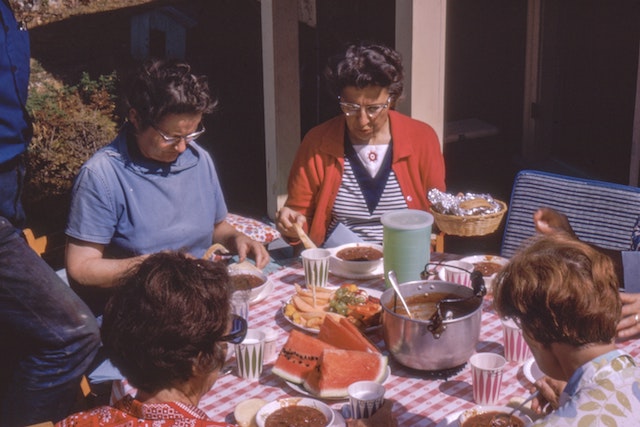Unlock the Magic in Your Story Now
Get the Free 20 questions to Ask Before Launching Your Idea workbook when you sign up for occasional updates.
Get the Free 20 questions to Ask Before Launching Your Idea workbook when you sign up for occasional updates.
Articles filed in: Marketing
That Certain Something

A new local grocery store around the corner from us finally opened its doors last weekend. For weeks we’ve been pressing our noses to the window as the new tenants swept the floor and stocked the shelves ready for the big day. The previous grocer stocked only organic produce, operated a juice bar and sold health supplements. He did well for many years until he expanded to two more locations that didn’t gain traction and eventually had to close all three.
Our new grocer tells us he doesn’t sell organic produce but he plans to stock more convenience food in the coming weeks. We’re not sure how his offering will be different enough from that of the two big-name supermarkets just four hundred metres walk from his door.
His store doesn’t sell anything customers can’t buy cheaper in another shop. He can’t compete on proximity, product range or price, so he needs to offer customers something they won’t get at the supermarket. It’s not yet clear what that ‘certain something’ is.
The people in our neighbourhood will try to support this new local store. They will pop in for a forgotten ingredient at 5 pm on a Tuesday evening or buy fresh flowers to cheer up a room at the weekend. But there won’t be enough of us buying sufficient volume to keep the lights on, and the shelves stocked.
Whatever we make, sell or serve, the question we must ask ourselves isn’t—if we build it, will they come? The harder and often scarier question to answer is—why would they come?
It sounds obvious, but we must give the people we want serve enough reasons to support us. Listing those reasons is a good place to start.
Image by Mehrad Vosoughi
The Value Conundrum
filed in Marketing, Strategy, Success

When I was growing up, my mother tried selling various products from home to earn extra money to support our family. I remember cookware and cosmetics being demonstrated to small groups of her friends over cups of tea and homemade sponge cake in the living room.
From day-to-day, Mum used the same old pans that had been handed down to her by my granny, and she hardly ever wore makeup. So her sales pitch usually came unstuck when she tried to demonstrate the products. She couldn’t show her friends how the products would make their lives easier or better.
Every purchase is a dance between risk and reassurance. The people we want to help must have faith in us before they can believe in the value we create or the stories we tell.
Image by Annie Spratt
To Whom It May Concern
filed in Marketing, Meaningful Work, Story Skills

When an aspiring author is pitching her work to a publisher or agent, she needs to address the agent directly.
In her query letter, it’s not enough to be aware of her book’s strengths—she must also know who it’s for and why this particular agent will care enough to read the first few chapters.
It doesn’t matter what idea you’re selling—it could be a logo, financial services or behaviour change, the same rules apply.
You’ll always get a better result when you open your pitch with the words, ‘Dear Someone Specific’ in your mind.
Act as if you’re writing a letter to a person you know, not a marketing message. Because you are.
Image by Green Chameleon
Your Goal Is To Matter To The People You Serve
filed in Marketing, Meaningful Work, Story Skills

I once worked with a startup in the financial services industry. The foyer of their office building was all polished floorboards, high white walls and minimal seating. Inspirational magazines were strategically arranged on low tables, next to the espresso machine.
The walls were completely bare apart from a big decal that declared how many customers the company had acquired. Proudly serving a million customers, it read.
That number was the story the company’s leadership team chose to tell. It was a story about growth, success and their upward trajectory. The goal was to build trust with visitors and excitement among the team. The number said something about the company’s values and aspirations, but it didn’t tell the whole story.
As part of our work together, I helped them to find and amplify individual customer stories. They went from talking about how many people they served to showing how they helped one small business at a time. Finding, owning and sharing their stories enabled them to demonstrate that they were not just a company that measured—they were a company that mattered.
That opportunity is open to all of us.
What stories can you tell today to show people why your work matters?
*Today is the last day to enrol in The Story Skills Workshop. You can join us at the special discounted rate for my blog readers using this link. Here are some of the stories of the people we’ve helped to become better storytellers.
Image by Hayley Phelps
Helpful Conversations

Over the past few weeks, my inbox has filled with emails from organisations I’d forgotten I’d ever had contact with. I must have signed up to an email list or bought something from them many years ago, but it’s so far back, I can’t remember why.
We’re all still trying to work out how to be useful to the people we serve in this moment. We want to help.
But the thing to remember about helpful conversations is that timing matters. Being helpful is not just about what you say or how you say it, it’s also about when you say it.
That doesn’t mean we need to stop talking, but it might just mean we need to be twice as good at listening, especially now.
Image by Fezbot
Say It Like You Mean It
filed in Marketing, Meaningful Work, Story Skills

Empathy is an essential skill for anyone who wants to make a living by serving others.
A big part of our job is to show those people that we see, hear and can help them.
But there’s a fine line between fake intimacy and genuine sincerity in a sales conversation. We’ve all been subjected to both.
The good news is we each get to choose which posture to adopt.
You can say it like you mean it, or better—you can mean it before you say it.
The integrity of sincerity wins in the long run.
Image by Adam Jang
The Best Stories Are Lived
filed in Marketing, Meaningful Work, Story Skills, Storytelling
 It’s Sunday afternoon, and I’m visiting the smallest branch of my favourite chocolate shop. It’s a fourth-generation, family-owned and operated business, and it shows.
It’s Sunday afternoon, and I’m visiting the smallest branch of my favourite chocolate shop. It’s a fourth-generation, family-owned and operated business, and it shows.
The enthusiasm of the assistants is palpable.
‘I’ve never worked for a company like this,’ the woman behind the counter says. ‘I’ve been here for five years, and I love it!’
When I ask why she talks about how much the owners care.
‘They’d do anything for us. They even get up on a ladder to change our lightbulbs. They remember our birthdays. They want the best for our customers and us.’
As the conversation progresses, ‘they’ becomes ‘we’.
‘We don’t export. We’re just proud to sell a beautiful Australian product at home.’
Storytelling is more than clever copy. It’s the act of showing up, with intention.
Your story is more than a tagline or a positioning statement—it’s not only what you say—it’s what you do.
The best stories are not just told, they are lived.
Image by Avant
Simple Questions To Ask When Your Marketing Isn’t Working
filed in Marketing, Storytelling, Strategy

My marketing isn’t working.
This sweeping declaration leads us to draw (sometimes incorrect), conclusions that influence our future marketing plans and business strategy. We can’t fix our marketing when we don’t know why it’s broken. But where do we start?
Here are seven questions to ask when your marketing isn’t working as well as you’d like.
7 Questions To Ask And Answer When Your Marketing Isn’t Working
1. Why isn’t this marketing working?
Not necessarily why, in fact, but why do you think—what’s your best guess as to the reasons you’re not achieving the results you want?
2. Did we reach enough of the right people?
How many people do you need to resonate with to achieve the numbers of sales or attract the clients you want?
3. How clear is the message?
Does your message clarify how exactly you solve your prospective customer’s problems, unmet needs or unspoken desires?
4. How well does the message resonate?
Do you know enough about your ideal customers to craft a message that resonates with them and calls them to act?
5. Are you meeting our prospective customers where they are?
Did you use the right medium, in the right place at the right time?
6. Did you give it enough time?
Is the marketing broken, or are you impatient to see results?
7. What would you change given your response to the first six questions?
What one thing can you do today to improve your marketing?
All marketing is testing. Rinse and repeat.
Image by Tim Mossholder
Why Should They Care?
filed in Marketing, Story Skills, Strategy

The ‘For Lease’ sign attached to the first-floor window of the shopfront is one of half a dozen along Gertrude Street. And the sales copy on each of them does nothing to differentiate one premises from the other.
The signs give us dimensions, details about the facilities and ‘good natural light’. They don’t for a second help a prospective tenant to translate those features into the benefits they care about.
It’s not enough to tell people what they get as part of the transaction today. We need to show them how those features will become benefits that matter to them in the long run.
Image by Garry Knight
Mass Awareness Vs. Minority Affinity
filed in Marketing, Story Skills, Strategy

The ‘golden arches’ glow at me in the distance as I set out for the gym before sunrise. It’s impossible to miss the 24-hour McDonald’s at the junction no matter which direction you travel. The ‘golden arches’ don’t distinguish the right potential customer from the wrong one. And that’s the point. McDonald’s strategy is to target everyone, so they cast their net far and wide, creating mass awareness. Their ideal customer can be any peckish stranger who happens to be passing by. This strategy works for McDonald’s, but it’s unlikely to work for us.
No other restaurant or cafe along this same street has the luxury of the ‘golden arches’. Like most of us with something to say, serve or sell, they have to do a better job of speaking to only their right customers. They don’t depend on the footfall of mass awareness—they thrive on the loyalty of minority affinity, built one customer at a time, over time. They understand what their customers want, they make promises, then show up consistently, week in week out, without fail to keep them.
There is no one-size-fits-all marketing strategy. The tactics we use must align with our goals and the goals of the people we want to serve. How are you creating affinity with the minority of people who enable you to do your best work?
Image by Joiarib Morales